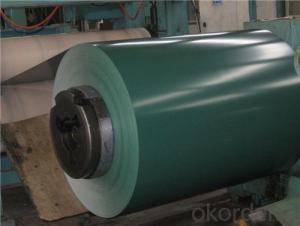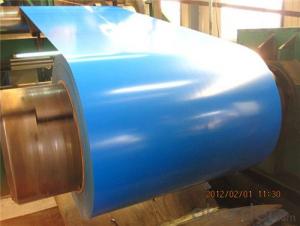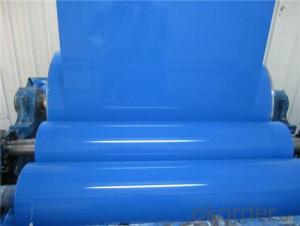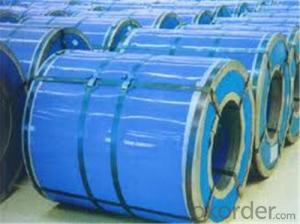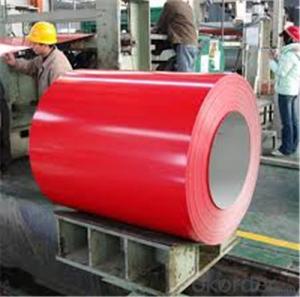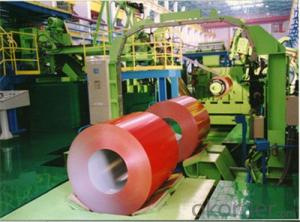Z3 BMP Prepainted Rolled Steel Coil for Constructions
- Loading Port:
- Shanghai
- Payment Terms:
- TT OR LC
- Min Order Qty:
- 100 m.t.
- Supply Capability:
- 30000 m.t./month
OKorder Service Pledge
OKorder Financial Service
You Might Also Like
Structure of Z3 BMP Prepainted Rolled Steel Coil for Construction

Description of Z3 BMP Prepainted Rolled Steel Coil for Construction
Cold rolled steel coil is steel that has been worked below its recrystallization temperature by passing it between a pair of rollers. Recrystallization temperature is the temperature at which grains in the lattice structure of the metal have been rearranged, leaving it free of strain and deformations. Cold rolled steel coil is pre-treated before being cold rolled with a process known as pickling, which uses strong acids to remove scale and other impurities. The cold rolled steel coil is then passed through rollers to reduce its thickness. Most cold rolling takes place in multiple passes and as the size of the cold rolled steel coil is further reduced, its strength and hardness both increase, but its ductility decreases. After cold rolling, heating the metal up in a process known as annealing can restore some of its ductility. The final cold rolled steel coil may be manufactured in the form of sheets, strips, bars, or other forms.

Main Feature of Z3 BMP Prepainted Rolled Steel Coil for Construction
1. Our company produce various specification and models and national standards of galvanized steel coil
2. Using high-quality material and advanced production technology and equipment for processing
3. Applicable to a humid climate and the harsh corrosive environment
4. Products has been all over the country more than 20 provinces, municipalities and autonomous regions, and have been exported to Europe, North American, the Middle East, the South East Asia, Africa, Asia,European and other countries and regions, well received by our buyer.
Applications of Z3 BMP PPGI Prepainted Rolled Steel Coil for Construction
1. Construction and building: Roofing; Ventilating duct; Handrail; Partition panel, etc.
2. Further processing: Coating base plate.
3. Electric appliance: Refrigerator; Washing machine; Recorder; Microwave, etc.
Our products have export to the South Africa, East Middle, Southeast Asia and South America. We have many old customers in many countries.
So if you are interested in our products, please don't hesitate to contact us
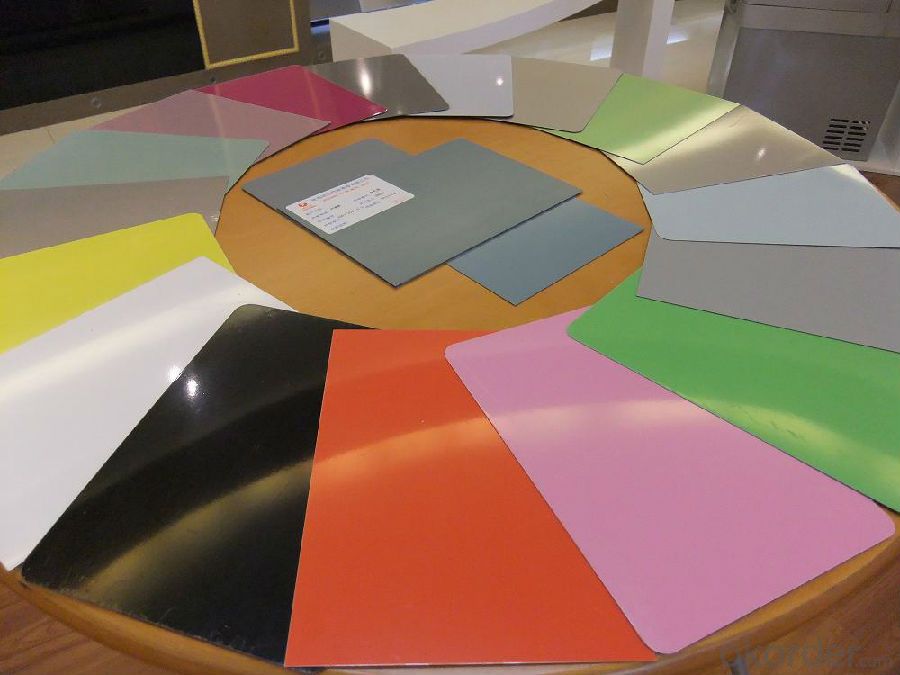
Specifications of Z3 BMP Prepainted Rolled Steel Coil for Construction
Product | Z3 BMP Prepainted Rolled Steel Coil for Construction |
Material Grade | SGCC / SGCH / DX51D+AZ, etc |
Thickness | 0.6-3.0mm |
Width | 500-1500mm |
Tolerance | Thickness: +/-0.02mm , Width:+/-2mm |
Zinc-coating | Z30-150g/m2 |
Technique | Raw material: Hot rolled steel coil --> Cold rolled_>hot dipped galvalume |
Surface | Dried, Chromated, Unoiled |
Spangle | Regular spangle , small spangle, zero spangle |
ID | 508MM 610MM |
Coil weight | 1-25MT |
Export package | Cardboard inner sleeves, Waterproof paper, galvanized steel covered and steel strip packed |
FAQ of Z38 BMP Prepainted Rolled Steel Coil for Construction
We have organized several common questions for our clients,may help you sincerely:
1. How Can I Visit There?
Our company is located in Tianjin City, China, near Beijing. You can fly to Tianjin Airport Directly. All our clients, from home or aboard, are warmly welcome to visit us!
2. How Can I Get Some Sample?
We are honored to offer you sample.
3. Why choose CNBM?
Our delivery time about 15-20days for standard sizes, if you have other requirements like hardness, quanity and width ,it is about 20-40days. But don't worry we also try our best for the delivery time ,because time longer and our cost is higher.
- Q:an 18k steel and gold, screw style bracelet how much would it be worth?
- If you use a Gold Calculator you can find out how much it is worth.
- Q:What are the common coil edge options?
- The common coil edge options include open coil edges, closed coil edges, and double heat-treated coil edges.
- Q:What exactly is surgical stainless steel made of (metals)? Does it contain nickel? If so, what % does it usually contain? I am deciding between surgical stainless steel piercings or titanium. Both same price and looks. I want to know which one is more hypo-allergenic and generally nickel free.
- surgical stainless steel is an austenitic steel containing 18-20% chromium and 8-10% nickel. and some proportion of molybdenum. The word 'surgical' refers to the fact that these types of steel are well-suited for making surgical instruments: they are easy to clean and sterilize, strong, and corrosion-resistant. The nickel/chrome/molybdenum alloys are also used for orthopaedic implants as aids in bone repair, and as a structural part of artificial heart valves and other implants. However, immune system reaction to nickel is a potential complication. In some cases today titanium is used instead in procedures that require a metal implant which will be permanent. Titanium is a reactive metal, the surface of which quickly oxidizes on exposure to air, creating a microstructured stable oxide surface. This provides a surface into which bone can grow and adhere in orthopaedic implants but which is incorrodible after implant. Thus steel may be used for temporary implants and the more expensive titanium for permanent ones
- Q:How would you calculate the maximum plastic deformation (expansion) a steel pipe can handle before it actually fails?
- You can calculate the maximum reversible strain, for elastic loading as follows: You need to look up the yield strength (for that particular type of steel). Divide this yield strength by the elastic modulus of steel (also called Young's modulus). That gives you the strain at the onset of yielding, the maximum you can strain the steel fibers before crossing the point of no return. If you are interested in the strain until failure, you need to take tensile test measurements. Seldom do people document an equation to model the non-elastic portion of the stress-strain curve of the specimen, because seldom do we design systems to operate with materials which yield. We want systems which only deform reversibly and elastically. This means you need to perform an experiment to find what you are actually desiring to know.
- Q:I'm a big fan of stainless steel and sterling silver, but not of the humidity of the country I'm in. Therefore I sweat more. Gross, I know. I'm buying a necklace chain for my ring.So does sweat contribute to tarnishing of silver and steel? The real kind?
- steel shouldn't really tarnish, it rusts and moisture increases that. Silver tarnishes when exposed to air and sulfur. Moisture increases the process a bit, but it happens anyway. Sweat is not gross, it's a necessary function of your body, otherwise you would die. A lot of sports people wear jewelry and they sweat a lot. If you wear the jewelry all the time, that will prevent the tarnish a bit. If you take it off, clean it (water and dish washing liquid), dry it and put it in a zip lock back to keep it away from air and moisture. In the end, cleaning the jewelry is quick and easy so don't worry about it.
- Q:How are steel coils used in the production of aerospace components?
- Steel coils find multiple applications in the production of aerospace components. One primary use involves their use in the manufacturing of structural parts like frames, beams, and brackets. To achieve this, steel coils are often transformed into flat sheets or strips, which are subsequently cut and shaped into the desired form for these components. Given the strong and durable nature of steel, it is an ideal material for these critical parts that must withstand extreme forces and conditions. Moreover, steel coils are also indispensable in the production of engine components, including turbine blades and combustion chambers. These components demand materials with exceptional mechanical properties and high resistance to elevated temperatures. Consequently, steel coils undergo processing and shaping to create intricate forms, ensuring the efficient and reliable functioning of these vital engine parts. Furthermore, steel coils play a crucial role in the production of fasteners, such as bolts, nuts, and screws, which are essential for assembling various aerospace components. The exceptional strength and corrosion resistance of steel make it the preferred choice for these fasteners, as they must endure the intense forces and harsh environments encountered during flight. In summary, the utilization of steel coils is of utmost importance in the production of aerospace components, as they provide the necessary strength, durability, and reliability required for safe and efficient operation in the demanding aerospace industry.
- Q:How are steel coils used in the production of roofing sheets?
- Steel coils are an essential component in the production of roofing sheets. These coils are typically made from high-quality steel, which is known for its durability, strength, and resistance to corrosion. They undergo a series of processes to transform them into roofing sheets. Firstly, the steel coils are loaded onto a machine called a decoiler, which unrolls the coils and feeds them into the production line. This machine ensures a continuous supply of steel for the manufacturing process. Next, the steel coils pass through a series of rollers, which shape the steel into the desired profile for the roofing sheets. These rollers can create various profiles, such as corrugated or standing seam, depending on the specific requirements of the roofing project. After the shaping process, the steel sheets are often coated with protective layers to enhance their durability. This coating can be in the form of zinc or other metallic alloys, known as galvanized or galvalume coatings, respectively. These coatings provide an additional layer of protection against rust and corrosion. Once the sheets are coated, they are typically cut to the desired length and width. This can be done using shearing machines or other cutting tools, ensuring that the roofing sheets are sized correctly for installation. Finally, the roofing sheets are packaged and prepared for distribution to construction sites. They are often bundled together and securely wrapped to protect them during transportation. In summary, steel coils are crucial in the production of roofing sheets. They undergo shaping, coating, cutting, and packaging processes to transform them into finished products ready for installation. The use of steel coils ensures that roofing sheets are strong, durable, and resistant to various environmental factors, making them a popular choice for roofing applications.
- Q:i found a similar question asking what metals were in stainless steel but i don't know if they are the same.... they probably aren't.
- steel is iron with a little bit of carbon mixed in. how much carbon determines the hardness of the steel. stainless steel is the same mostly, it has nickle and chromium added in to make it corrosion resistant.
- Q:What is the market demand for steel coils?
- The market demand for steel coils varies based on several factors such as industry requirements, economic conditions, and global trade patterns. However, steel coils have a significant demand across various sectors including construction, automotive, manufacturing, and infrastructure development. The demand for steel coils is driven by their versatility, strength, and durability, making them a crucial component in various applications.
- Q:i want to know what is light gauge steel and the diffrences between light gauge steel and steel for roof truss.
- as a welder i can answere this. wel i think i can after 2 years of classes. so...light guage steel usually referes to the THICKNESS of the metal. also known as SHEET METAL. the only diffrences between light guage and roof truss is that a truss will be thicker metal ex- an i-beam for a structure is usually 1/2inch or 3/8 for smaller buildings. also there is no such thing as light weight steel. steel is steel the only thing that determins its weight is its size/thickness aluminum is a whole nother ballgame. ever see a pound of aluminum vs. a pound of steel? aluminum can be 1/2 or less the weight of steel. but its tensile strength suffers EX. say steel will snap at 70,000 pounds, aluminum will snap at 40,000 pounds, if it even snaps that is! it just tends to bend like rubber. aluminum is handy for many things because it will not rust.
1. Manufacturer Overview |
|
|---|---|
| Location | |
| Year Established | |
| Annual Output Value | |
| Main Markets | |
| Company Certifications | |
2. Manufacturer Certificates |
|
|---|---|
| a) Certification Name | |
| Range | |
| Reference | |
| Validity Period | |
3. Manufacturer Capability |
|
|---|---|
| a)Trade Capacity | |
| Nearest Port | |
| Export Percentage | |
| No.of Employees in Trade Department | |
| Language Spoken: | |
| b)Factory Information | |
| Factory Size: | |
| No. of Production Lines | |
| Contract Manufacturing | |
| Product Price Range | |
Send your message to us
Z3 BMP Prepainted Rolled Steel Coil for Constructions
- Loading Port:
- Shanghai
- Payment Terms:
- TT OR LC
- Min Order Qty:
- 100 m.t.
- Supply Capability:
- 30000 m.t./month
OKorder Service Pledge
OKorder Financial Service
Similar products
New products
Hot products
Related keywords
